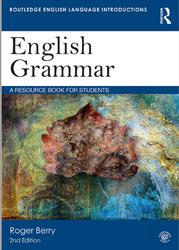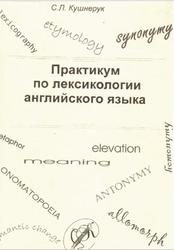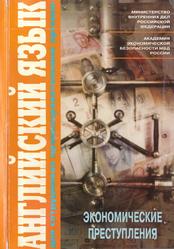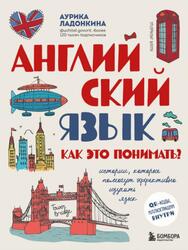Collins COBUILD English Guides provide extensive information on specific areas of today’s English, using the evidence from The Bank of English to select what is really important.
This book is suitable for upper-intermediate and advanced students and teachers of English. It focuses on the most frequent words in English: the definite article the and the indefinite article a or an.
Articles are a recognized problem area for learners of English and this book provides comprehensive treatment of them It describes the different uses of articles, and explains those situations in which no article is used.
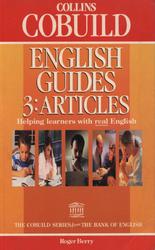
The definite and indefinite articles.
This book deals with two words. These are the definite article, the, and the indefinite article, a or an.
The rug was stained.
I have an idea she had a weight problem.
This chapter explains how these words are written and spoken; that is, the form of the words. Section 1.2 discusses the definite article in writing and speech, and section 1.3 discusses the indefinite article in writing and speech. Section 1.4 deals with the way the articles are pronounced when they are stressed.
The forms of the articles and the rules for using them are not complicated. However, you may find it difficult to recognize the articles in spoken English; this is particularly true of the indefinite article. Usually it is unstressed and so it occurs in very short syllables. You may need to become familiar with the rhythm of English in order to notice these short unstressed syllables.
Contents.
Foreword.
Introducdon.
Pronuncladon Guide.
Chapter 1: The forms ofthe articles.
1.1 The definite and indefinite articles.
1.2 The definite article.
1.3 The indefinite article.
1.4 Stressed forms.
Chapter 2: ArtIcles and nouns.
2.1 Introduction.
2.2 Count nouns.
2.3 Uncount nouns.
2.4 Uncount nouns whose equivalents in other languages are count nouns.
2.5 Plural nouns.
2.6 Nouns which can be count or uncount.
2.7 Converting uncount nouns to count nouns meaning'a unit of'.
2.8 Converting uncount nouns to count nouns meaning'a type of'.
2.9 Convertin~ count nouns to uncount nouns.
2.10 Nouns which can be count or uncount with different meanings.
2.11 Using counting expressions such as 'a piece of and 'a bit of with uncount nouns.
Chapter 3: Using the indefinite article.
3.1 Introduction.
3.2 Using the indefinite article to introduce something.
3.3 Referring to any thing or person of a particular type.
3.4 Using the indefinite article to describe things arid people.
3.5 The indefinite article and 'one'.
3.6 Using the indefinite article to express rates.
3.7 Using the indefinite article with abstract uncount nouns.
Chapter 4: Speclftc uses ofthe definite article.
4.1 Introduction: different uses of the definite article.
4.2 Referring to a particular thing using the definite article or indefinite article.
4.3 Referring back to something mentioned before.
4.4 Something mentioned before: using another noun.
4.5 Things associated with a previous mention.
4.6 Surrounding situation.
4.7 Wider situations.
4.8 Referring to unique items.
4.9 Nouns with quabfication.
4.10 Nouns qualified byan 'of'-phrase.
4.11 Superlative adjectives.
4.12 Unique adjectives.
4.13 Using the definite article at the beginning of stories.
4.14 Stressed 'the' meaning 'best'.
Chapter 5: ArtIcleswith generic reference.
5.1 Introduction: different types of generic reference.
5.2 Singular count nouns with the indefinite article.
5.3 Sin~Jar count nouns with the definite article.
5.4 Nationality words with the definite article.
5.5 Adjectiveswith the definite article.
5.6 'Man'.
Chapter 6: ArtIcleuse with certain groups of words.
6.1 Introduction.
6.2 Media and communications.
6.3 Means of transport.
6.4 Forms of entertainment.
6.5 Institutions in society.
6.6 Shops and other businesses.
6.7 Musical instruments.
6.8 Geographical oppositions.
6.9 Directions.
6.10 Periods of time.
6.11 Illnesses.
6.12 Meals.
6.13 Parts of the body.
6.14 Special roles.
6.15 Grammatical terms.
Chapter 7: Articlesand proper nouns.
7.1 Introduction: proper nouns.
7.2 Geographical and place names with the definite article.
7.3 Geographical and place names without an article.
7.4 Names of buildings and institutions.
7.5 Names of streets and roads.
7.6 Names of ships, trains, and spacecraft.
7.7 Names of sporting events.
7.8 Names of festivals.
7.9 Names of organizations.
7.10 Names of newspapers and periodicals.
7.11 Names of political institutions.
7.12 Names of musical groups.
7.13 Personal names.
7.14 Converting proper nouns.
Chapter 8: Articles in the noun group.
8.1 Introduction: the noun group.
8.2 Combining articles with other determiners.
8.3 Combining determiners with the definite article.
8.4 Combining determiners with the indefinite article.
8.5 'Afew' and 'a little'.
8.6 Nouns as modifiers.
8.7 Word order with 'so', 'how', 'too', 'as', and 'that'.
8.8 Leaving out articles.
8.9 The definite article with adjectives meaning 'something.'.
8.10 The definite article with comparative adjectives and adverbs.
Exercises.
Answer Key.
Index.
Бесплатно скачать электронную книгу в удобном формате, смотреть и читать:
Скачать книгу Collins Cobuild, English Guides 3, Articles, Berry R., 1996 - fileskachat.com, быстрое и бесплатное скачивание.
Скачать pdf
Ниже можно купить эту книгу, если она есть в продаже, и похожие книги по лучшей цене со скидкой с доставкой по всей России.Купить книги
Скачать - pdf - Яндекс.Диск.
Дата публикации:
Теги: учебник по английскому языку :: английский язык :: Berry
Смотрите также учебники, книги и учебные материалы:
Следующие учебники и книги:
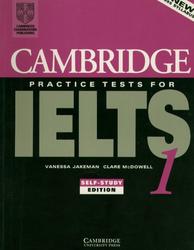 Cambridge Practice Tests for IELTS 1, Jakeman V., McDowell C., 1996 — This book contains practice material for the International English Language Testing System: four complete practice testa for Academic candidates, plus … Книги по английскому языку
Cambridge Practice Tests for IELTS 1, Jakeman V., McDowell C., 1996 — This book contains practice material for the International English Language Testing System: four complete practice testa for Academic candidates, plus … Книги по английскому языку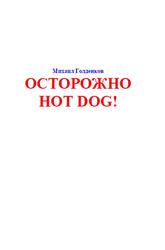 Осторожно Hot Dog, Современный активный English, Голденков М.А., 1999 — Когда автора спросили, какими он считает свои книги развлекательно-познавательными или учебными, Михаил Голденков ответил, что рассматривает их как своего рода … Книги по английскому языку
Осторожно Hot Dog, Современный активный English, Голденков М.А., 1999 — Когда автора спросили, какими он считает свои книги развлекательно-познавательными или учебными, Михаил Голденков ответил, что рассматривает их как своего рода … Книги по английскому языку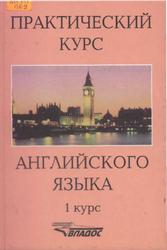 Практический курс английского языка, 1 курс, Селянина Л.И., Гинтовт К.П., Соколова М.А., Аракин В.Д., 1998 — Серия учебников предназначена для студентов педагогических вузов и предполагает преемственность в изучении английского языка с I по V курс. Цель … Книги по английскому языку
Практический курс английского языка, 1 курс, Селянина Л.И., Гинтовт К.П., Соколова М.А., Аракин В.Д., 1998 — Серия учебников предназначена для студентов педагогических вузов и предполагает преемственность в изучении английского языка с I по V курс. Цель … Книги по английскому языку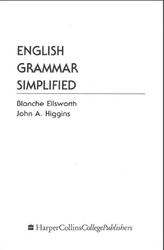 English Grammar Simplified, Ellsworth B., Higgins J.A., 1997 — English Grammar Simplified is a complete reference guide for writing. Sections on grammar, punctuation, mechanics, and usage make this a … Книги по английскому языку
English Grammar Simplified, Ellsworth B., Higgins J.A., 1997 — English Grammar Simplified is a complete reference guide for writing. Sections on grammar, punctuation, mechanics, and usage make this a … Книги по английскому языку
Предыдущие статьи:
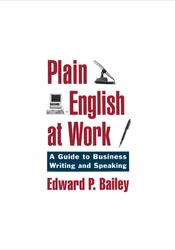 Plain English at Work, A Guide to Writing and Speaking, Bailey E., 1996 — This book combines and significantly updates two previously separate books of mine: • The Plain English Approach to Business Writing … Книги по английскому языку
Plain English at Work, A Guide to Writing and Speaking, Bailey E., 1996 — This book combines and significantly updates two previously separate books of mine: • The Plain English Approach to Business Writing … Книги по английскому языку Five-Minute Activities, A resource book of short activities, Wright A., 1996 — Фрагмент из книги. You and your students may like the idea of having a regular five-minute slot in your lesson … Книги по английскому языку
Five-Minute Activities, A resource book of short activities, Wright A., 1996 — Фрагмент из книги. You and your students may like the idea of having a regular five-minute slot in your lesson … Книги по английскому языку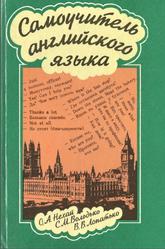 Самоучитель английского языка, Hexaй О.A., Володько C.M., Лопатько В.В., 1995 — Итак, приступаем к изучению английского языка. Вы постепенно знакомитесь с фонетическими особенностями его согласных звуков, затем гласных, интонации и ударения. … Книги по английскому языку
Самоучитель английского языка, Hexaй О.A., Володько C.M., Лопатько В.В., 1995 — Итак, приступаем к изучению английского языка. Вы постепенно знакомитесь с фонетическими особенностями его согласных звуков, затем гласных, интонации и ударения. … Книги по английскому языку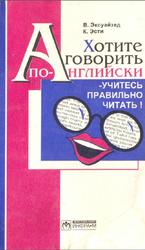 Хотите говорить по-английски - учитесь правильно читать, Эксуайзед В., Эсти К., 1995 — Методическое пособие В. Эксуайзеда и К. Эсти предназначена для тех, кто хочет научиться читать и писать по-английски без ошибок. Авторы … Книги по английскому языку
Хотите говорить по-английски - учитесь правильно читать, Эксуайзед В., Эсти К., 1995 — Методическое пособие В. Эксуайзеда и К. Эсти предназначена для тех, кто хочет научиться читать и писать по-английски без ошибок. Авторы … Книги по английскому языку

